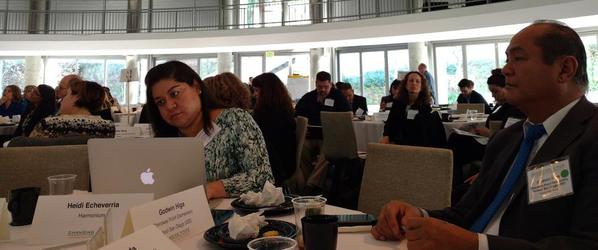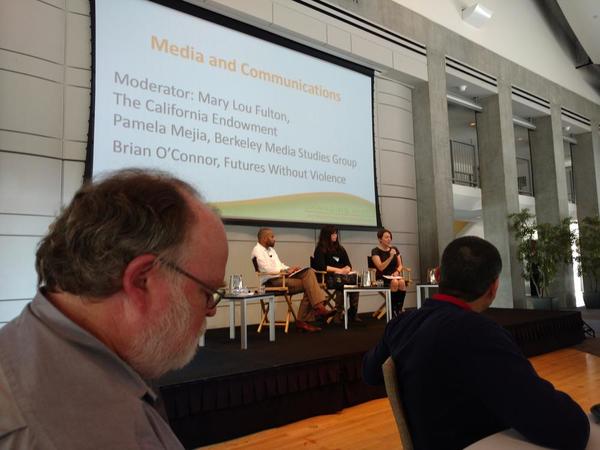Last week, on two separate days in Los Angeles and in San Francisco, about 150 people (total) convened to listen and brainstorm about creating trauma-informed communities. Futures Without Violence, which is rolling out its Changing Minds campaign later this year, hosted both events.
Some very interesting and important themes emerged from the two days:
- Residents with lived experiences should participate in the decision-making bodies of service providers and vested stakeholders.
- Move away from "evidence-based best practices" to foster a common language of "what's working" and trust what is emerging.
- Funders should receive ACEs and trauma-informed training.
- Share data across sectors.
The jam-packed, inspiring two days were precursors to three days May -- in Southern California, Northern California and San Francisco Bay Area -- that will focus on how to translate inspiration into action, and sharing strategies and tactics. The workshops are organized for, and designed by, people who are driving ACEs or trauma-informed initiatives in their communities. We at ACEs Connection are hosting the workshops. (If you're interested, contact one of us...emails at the end of this post.)
Dana Brown and Alicia St. Andrews, ACEs Connection community facilitators who attended the Changing Mind workshops, provided these highlights from last week's workshops:
The participants at the LA convening came from the counties of Los Angeles, Orange, San Bernardino, San Diego and Ventura, as well as the cities of Fresno and Long Beach.

Heidi Echeverria, from Harmonium Inc., and Godwin Higa, principal of Cherokee Point Elementary
Those in San Francisco comprised primarily systems leaders from the counties of Alameda, Contra Costa, El Dorado, Merced, San Mateo, and Santa Clara; the cities of Merced, Sacramento, Salinas, and San Jose; and staff members from Trauma Transformed.
Esta Solar, CEO of Futures without Violence, said that childhood trauma is the number one public health issue in our country and is hidden in plain sight, and made these three points: Budget constraints cannot constrain our work. We need to use a lens of equity and fairness. And movements are made of moments.
Peter Long, from Blue Shield of California Foundation, who moderated a panel, said, "The movement to end childhood trauma is moving in your communities. We are here to clarify the movement with humility as the spirit of the day," and referred to "forming, storming, norming, performing," the stages of group development.
Brian Sims, from the National Center for Trauma Informed Care, which is housed at the Substance Abuse and Mental Health Services Administration (SAMHSA) suggested that the way to provide information without being prescriptive was to listen. He explained that SAMHSA’s most recent trauma-informed community-based efforts are centered around listening sessions in which the voices of all staff are heard, from janitors to receptionists because trauma-informed services have to be provided in trauma-informed environments.
Practitioners must embrace temporary and utter chaos in order to reach meaningful, non-prescriptive change, he said. In one community, 50 city officials and 60 police officers were brought together. At first all they could do was yell at each other, he said. Then they listened. And now they volunteer. The take-away? Communities address issues through collaboration, and listening skills are the greatest value point available.
Renee Boynton-Jarrett, a pediatrician at Boston University School of Medicine and founder of Vital Village Network, said that she opens all community meetings by greeting “the family” in the room. She explained that the place you live shapes your ability to develop optimally as a child, systematic inequities exist and are dictated by geography (it's a non-random process), and absence of violence is not equal to promotion of enrichment.
When Boynton-Jarrett moved to Boston she went to community meetings and passionately talked and talked and provided evidence-based best practices, she said. But nobody listened. “We need to listen,” she said, "It's a process issue, not a practice issue. We need to think differently about feedback and co-creation. Everyone needs to be be present as a learner, even and especially the experts in the room." As an example, she explained that Community Based Participatory Research (CBPR) is embedded in all levels of network activities.
K-Rahn Vallatine, from Live Above The Hype, challenged everyone to look at “evidence-based best practices” and how/if they authentically transform individuals and communities and efficacy outcomes. Many people with lived experience from the most traumatized communities say that evidence-based practices don't work for them. btw, Live Above the Hype targets the "counter-productive value systems inherent in trauma-organized cultures". [Ed. note: What an apt phrase...our culture is indeed trauma-organized. Our systems manage trauma, and we'd like to see them prevent trauma and stop traumatizing already traumatized people.]

Mary Lou Fulton, from The California Endowment, moderated the lunch panel. Pamela Mejia, Berkeley Media Studies Group, reviewed research of how ACEs and trauma appear in the news. Brian O’Connor, Futures Without Violence, reviewed the Changing Minds national campaign.
Jason Grant, a graduate student at the University of San Francisco coaches basketball at Merritt, a community college in Oakland. Even though he's a young black man from Hunters Point in San Francisco, Grant said, he still had “no idea” what his players were going through. Grant grew up in a supportive community. His mother always had him enrolled in after-school and summer programs, which he credits for keeping him in check. Many of his team members frequently experience food insecurity and homelessness. He was the first male role model and authority figure for most, if not all of his team members.
“Basketball is a quick game with many highs and lows,” said Grant. “Emotions switch on and off,” with great intensity and frequency. This mirrored the day-to-day survival mode experienced by Grant’s team members. Through relationships with team members on and off the court, Grant learned the difference between reacting and responding to emotions. “Resilience is the space between reacting and responding,” says Grant, and the skills he relied on to build resilience in his team members is focused on mindfulness techniques.
Erin Fairchild, from the Defending Childhood Initiative in Multnomah County, Oregon, said that more than 5,000 adults have been trained in trauma-informed approaches across the county, with a focus on workforce development. She said it wasn't enough. “We need to operationalize it,” she explained, which requires “stepping back to evaluate and change the environment of the system.”
It’s not just about refraining from re-traumatizing your clients, it’s about figuring out how to go out and organize your community, she said. If people with lived experience are hired to go out into the community to address racism and trauma, they need to come back to an agency where they experience a trauma-informed system, where leadership matches experiences on the front lines.
To achieve this, the initiative started with training on trauma-informed approaches. Then, they used the trusting relationships established through training to create more reflective processes between people in the workforce. The initiative hosted and facilitated learning collaboratives where people could go out, practice things, and come back to “speak truth to power” and collaboratively reflect in an iterative growth process. “There’s many on board with trauma-informed practices,” says Fairchild, “but not the racism piece. It’s a big ask to go beyond training and curriculum and figure out what it means to hire people with lived experience and bring them back to an agency that’s not trauma-informed.”
Jill Habig, an attorney who works for Attorney General Kamala Harris, explained why the attorney general was talking about childhood trauma and elementary school education. “Because it is way too late and far too expensive to wait,” said Habig. She quoted Harris: “We cannot continue to fail our children, act surprised, and lock them up later.”
When asked about alignment between Children Now and the Defending Childhood Initiative, Habig said that the biggest challenge is “uniting California state initiatives, having the right space for the right people to communicate, and creating a manageable number of shared indicators. It takes community involvement to shape state policy. We need to figure out how to highlight, scale, and replicate models from 58 communities and counties so no one has to reinvent the wheel. What is an open-source venue for that?”
Well, with all humility, we think it's ACEs Connection.
For information about participating in the upcoming workshops in May, contact: Southern California: Dana Brown, dbrown@acesconnection.com
Northern and Central California: Gail Kennedy, gkennedy@acesconnection.com
San Francisco Bay Area: Alicia St. Andrews, astandrews@acesconnection.com



Comments (0)